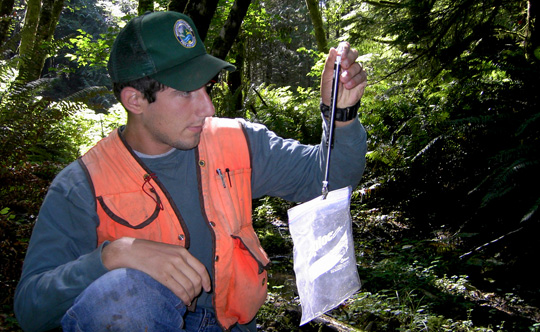Letting Science Lead the Way
Consistent with statutes of the Forests and Fish Law, Washington’s private forest landowners rely on peer-reviewed science to help create and evaluate sustainable forest practices.

Adaptive Management:
Letting Science Lead the Way
Science in Action
Adaptive Management: Focus on Four Key Goals
More than 140 individuals, including scientists, policy makers, and regulators worked together for 18 months to develop the scientifically-based changes to forest practices rules found in the Forests & Fish Law to meet four key goals established by the Forest Practices Board:
- Provide compliance with the Endangered Species Act for aquatic and riparian-dependent species.
- Restore and maintain riparian habitat to support a harvestable supply of fish.
- Meet the requirements of the Clean Water Act for water quality.
- Keep the timber industry economically viable in the state of Washington.Click here to see more information about the private timber industry’s contribution to the state economy.
The rules are monitored on the ground to ensure the objectives of restoring salmon habitat and protecting water quality are being met. If they are not, the rules will be changed through peer-reviewed scientific determination and Adaptive Management. This allows for rule changes if science shows it to be necessary.
Forest Practices Habitat Conservation Plan (FPHCP)
On June 5, 2006, the federal government approved a 50-year Habitat Conservation Plan endorsing the State Forest Practices Program for protecting fish and water quality. The FPHCP was developed with recommendations from the multi-stakeholder Forests & Fish Report, adopted into rule July 2001. Forest practices result in improved aquatic and riparian habitat as well as improved water quality that better meet the ecological needs of fish and water.
The FPHCP created and implemented an effective Adaptive Management Plan for three reasons:
- To ensure change will occur as needed
- To provide stability in the process of change and
- To ensure quality controls are applied
Progress is measured through resource objectives
Progress toward reaching the four goals is measured through a set of resource objectives established by scientists for key aquatic conditions and processes. These objectives are designed to meet the conditions that salmon need to thrive during various phases of their life cycle.
Scientific research is being conducted to test the effectiveness of forest practices to determine whether resource objectives are providing:
- Cool water by maintaining shade
- Large woody debris for in-stream habitat
- Clean water by protecting unstable slopes and improving roads to prevent excessive sediment from entering into streams
- A natural hydrologic regime by disconnecting road drainage from streams
- Preventing application to surface water and retaining natural vegetation buffers along streams to prevent silvicultural herbicides from entering the streams
- Fish habitat for all life stages at any time of the year by correctly classifying streams and removing barriers to fish passage
Adaptive Management and Program Refinements
Adaptive Management is a method for examining alternative strategies and is the mechanism for refining protection measures in an ongoing cycle of learning and improving over-time. The process complements the forest practices rules in two ways: 1) addressing near-term uncertainties, and 2) ensuring compliance with the Endangered Species Act over the long-term.
The Forest Practices Board formally established the adaptive management process which is managed and implemented by four entities:
- Cooperative Monitoring Evaluation and Research Committee (CMER). Provides an integrated strategy for considering, prioritizing and conducting research and monitoring to inform policy representative and the FPB.
- Adaptive Management Program Administrator (AMPA). Supports CMER, assures objectivity of the science work and manages the business affairs of the committee.
- Forests and Fish Policy Group (FFPG). A collaborative forum of policy level people who informally advise CMER on routine matters and provide the FPB with consensus rule recommendations flowing from the scientific results provided by CMER.
- The majority of the 13 member board is appointed by the Governor and the board members represent the state agencies and regulated community governed by the Forest Practices Act and Rules.
The Washington State Legislature established the Forests & Fish Account in March 2006, funded by a surcharge on the Business and Occupation tax on forestry to provide adequate funding for adaptive management and monitoring of the implementation of the Forest Practices Habitat Conservation Plan.